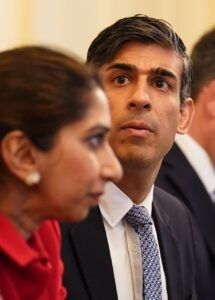DO not expect any more parties in Downing Street this week to mark the anniversary of Rishi Sunak becoming prime minister. It was an understated moment of British social history, as Britain’s first Asian prime minister walked into Number 10 alone, with a few words about fixing mistakes to get the economy back on track. The political message to his party was a stark one: “unite or die”.
If economic recovery has been a hard slog, political unity has been harder still to come by. Two of the biggest by-election defeats in post-war political history confirm that Sunak’s political prospects are shakier now than they were a year ago. Opinions differ on whether the problem was an almost impossible inheritance, or how he has played a difficult hand, but the growing consensus acknowledges that the path to an unlikely electoral comeback is narrower than ever.
This anniversary introduces a new danger. It ends the 12-month grace period during which a new leaders cannot face a formal no confidence vote; 53 Conservative MPs can now trigger such a ballot. Destabilising headlines about how many may be tempted have already begun, but most of Sunak’s colleagues think another leadership change is crazy talk. It would take a majority of his MPs – 176 MPs – to actually sack Sunak. Losing a first prime minister to the partygate scandal may have been a misfortune, but losing a second to the Trussonomics implosion felt more like carelessness. A third change would be a political circus. Potential successors may rather wait until after the general election than try to wrest what may be a poisoned chalice from Sunak now.

Arguably, bringing back Boris Johnson – the prime minister last time the public were asked – could be more legitimate than introducing a fourth prime minister in one parliament. But Johnson left the Commons, so would need a by-election to come back in. The fantasy of Johnson’s return can be left to political fiction. So I expect Sunak to survive, but threats of a no-confidence vote may feature in party arguments on flashpoint issues – including tax, immigration and whether to threaten to leave the European Convention on Human Rights.
Prime ministers struggling politically are never short of advice – mostly from people arguing that their own hobby-horses would deliver a dramatic political comeback. Johnson understood that the 2019 victory was won partly with the votes of people who do not identify with the Conservatives. “I can imagine people’s pencils hovering over the ballot paper and wavering,” he said, noting some voters were breaking the habit of generations. Many Conservative commentators seem to have forgotten this, always arguing that Sunak needs to move right to recover – by cutting tax and spending, slashing immigration or dialling up the ‘war on woke’ – rather than addressing the cost of living and the NHS.
Focusing on voters flirting with Reform and those who are currently undecided looks like a “limit the damage” strategy to try to get back towards 35 per cent in the polls. That could create a path to denying Labour an overall majority. But Sunak has no serious path back to Downing Street without also targeting the five pe cent of the electorate who have switched directly from Conservatives to Labour – and who ‘count double’ in head-to- head marginal seats.
The length of Sunak’s stay in 10 Downing Street may depend primarily on when he decides to hold the general election. A new More in Common survey shows most of the public want this to be as soon as possible. They are likely to be disappointed. The Labour opposition plan to taunt a mandate-less prime minister for delaying the moment of electoral reckoning, but Sunak looks set to play it long.

These by-election defeats put the final nail in the coffin of a May 2024 general election to coincide with the Mayoral and local elections. Early Autumn has little appeal. Unless the government really could ‘stop the boats’, those Channel crossings tend to peak in August and September. An October election would mean a clash with the US Biden-Trump showdown. A useful new Institute of Government briefing comparing these scenarios may leave its readers thinking that the latest date possible – 23rd January 2025 – may be an underestimated possibility. That would provoke public annoyance at election campaigning through the Christmas holiday. My own hunch is for December 12, 2024, the fifth anniversary of the last general election.
So, Sunak’s big choices for the next year include the election date, how to balance governing and campaigning, and the content of his re-election campaign. His battle against inflation constrains the scope for a tax cuts or spending giveaways. The prime minister wants to engage in long-term issues, from the Middle East to the future of Artificial Intelligence, which have limited electoral salience. As a party leader, Sunak must keep pushing for a near-miraculous electoral turnaround. It may be that the character of the forthcoming campaign, one rather more likely to result in defeat than victory, will ultimately define the Sunak legacy.
